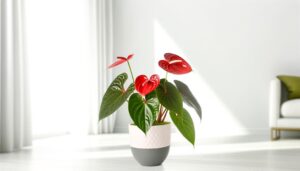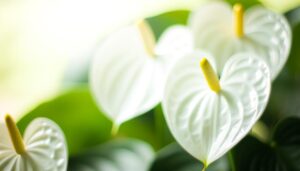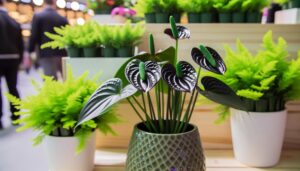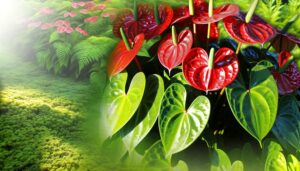Unique Traits of the Bali Red Anthurium
The Bali Red Anthurium (Anthurium andraeanum) is a striking member of the Araceae family, distinguished by its vibrant crimson spathes and glossy, heart-shaped leaves. Originating from Central and South America, this cultivar thrives in humid environments with indirect light and acidic, well-draining substrate.
Notable for its compact growth habit and alternating leaf arrangement, it excels in varying humidity and soil conditions. The plant benefits from balanced, slow-release fertilizers and consistent watering, making it ideal for diverse horticultural settings.
Discover more about its unique resilience and ornamental appeal in the following sections.
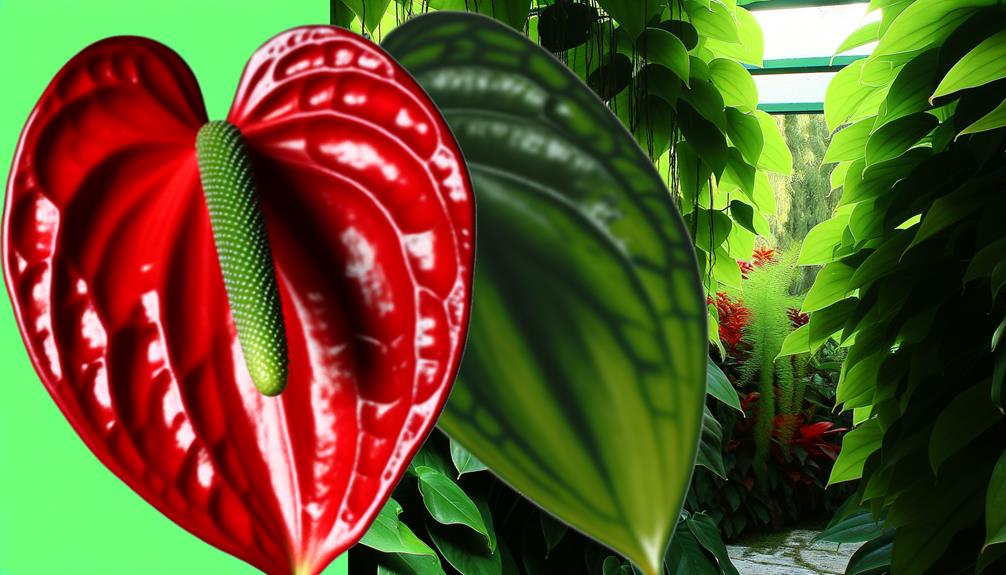
Key Takeaways
- Vibrant crimson spathes with a waxy texture.
- Glossy, heart-shaped, deep green leaves.
- Adaptable to varying humidity and light conditions.
- Efficient in improving indoor air quality.
- Compact growth habit suitable for indoor containers.
Origin and History
The Bali Red Anthurium, scientifically known as Anthurium andraeanum 'Bali Red', originates from the tropical rainforests of Central and South America. It has been selectively bred for its striking red spathes and robust foliage. This cultivar belongs to the Araceae family, distinguished by its epiphytic growth habit and heart-shaped leaves.
Preferring humid environments with ample indirect light, the Bali Red thrives in well-draining, organic-rich substrates. Its prime growth conditions include temperatures between 18°C and 25°C and humidity levels above 70%. The Bali Red Anthurium has adapted to lower light conditions, making it a versatile choice for both indoor and outdoor cultivation.
Proper care guarantees its longevity and vibrant appearance, contributing to its popularity in ornamental horticulture.
Unique Aesthetic Features
Characterized by its vibrant crimson spathes and glossy, heart-shaped leaves, the Bali Red Anthurium exhibits unique aesthetic features that distinguish it from other Anthurium cultivars. Its spathes, or modified leaves, are not only intensely colored but also exhibit a waxy texture, enhancing their visual appeal. The foliage, mainly dark green, provides a striking contrast to the red spathes. This cultivar's compact growth habit makes it ideal for ornamental use in both indoor and outdoor settings.
| Feature | Description | Significance |
|---|---|---|
| Spathes | Vibrant crimson, waxy texture | Enhances visual appeal |
| Leaves | Glossy, heart-shaped, deep green | Provides striking contrast |
| Growth Habit | Compact | Suitable for ornamental use |
| Leaf Arrangement | Alternating | Aesthetic foliage display |
| Spadix | Yellow or white | Adds color diversity |
These characteristics collectively contribute to the Bali Red Anthurium's unique ornamental value.
Growth and Development
The Bali Red Anthurium (Anthurium andraeanum) thrives in humid environments with temperatures ranging between 65-80°F and indirect sunlight, which are best for its photosynthetic efficiency and overall vigor.
During its maturation phase, the plant exhibits a robust growth rate and enters its blooming cycle, producing vibrant red spathes.
Consistent watering, well-draining soil, and periodic fertilization are essential to support its development and prolific flowering.
Ideal Growing Conditions
Best cultivation of the Bali Red Anthurium necessitates maintaining high humidity levels and providing consistent, indirect sunlight to support its photosynthetic processes. This species, Anthurium andraeanum, thrives in environments where relative humidity is kept between 70-80%, mimicking its native tropical habitat.
The plant demands well-draining, aerated soil rich in organic matter to prevent root rot and optimize nutrient uptake. Ideal temperature ranges are between 20-30°C (68-86°F), avoiding fluctuations that could stress the plant. Additionally, a balanced, slow-release fertilizer applied bi-monthly promotes robust growth.
Ensuring adequate air circulation is essential to mitigate fungal infections. Consistent monitoring of these parameters guarantees the Bali Red Anthurium's healthy development and longevity, nurturing its distinct, vibrant foliage.
Maturation and Blooming
Achieving full ripeness, the Bali Red Anthurium goes through a series of growth stages marked by the progressive expansion of its shiny, heart-shaped leaves and the emergence of its distinctive red spathes.
Initially, young leaves display a smaller, more delicate structure, gradually adopting the species' characteristic sturdy morphology.
The blooming phase begins when the plant reaches a suitable level of vegetative growth, typically under ideal conditions of humidity (70-80%) and temperature (20-30°C). During this reproductive phase, inflorescences appear as vividly colored spathes, each enclosing a spadix that is abundant in reproductive organs.
The flowering period, influenced by photoperiod and nutrient availability, guarantees successful pollination and subsequent seed development. This maturation process concludes in a visually stunning and scientifically significant specimen.
Resilience and Adaptability
Renowned for its remarkable resilience, the Bali Red Anthurium thrives in a variety of environmental conditions, demonstrating a unique adaptability that sets it apart from other species.
Classified under the family Araceae, the Bali Red Anthurium exhibits robust physiological traits, including a well-developed root system and thick, waxy leaves that reduce transpiration.
This species can withstand fluctuating humidity levels, partial shade, and varying soil compositions, from loamy to slightly acidic substrates. Its adaptability extends to temperature tolerance, enduring both tropical warmth and cooler microclimates.
The plant's innate ability to adjust its metabolic processes guarantees survival under stress, making it a resilient choice for diverse horticultural settings. This adaptability underscores its ecological versatility and horticultural value.
Ideal Growing Conditions
The Bali Red Anthurium thrives most effectively in environments with indirect sunlight, maintaining soil moisture at a consistent level without waterlogging.
Classified under the Araceae family, Anthurium species prefer a well-draining substrate, rich in organic matter.
Most favorable growth conditions include temperatures between 18-25°C (64-77°F) and humidity levels above 60%.
The plant benefits from a balanced, slow-release fertilizer applied bi-monthly during the growing season.
Ensuring adequate air circulation is crucial to prevent fungal infections.
The pH of the soil should remain slightly acidic, ideally between 5.5 and 6.5.
Providing these conditions promotes vigorous growth and enhances the vibrant red spathes characteristic of the Bali Red Anthurium, ensuring its ornamental appeal and health.
Common Care Practices
Proper upkeep of the Bali Red Anthurium involves regular watering schedules, precise trimming techniques, and vigilant pest control to ensure plant health and aesthetic appeal.
Consistent hydration is crucial, ensuring the soil stays moist but not saturated, as excessive moisture can lead to root rot.
Trimming should be done to eliminate aging leaves and used flowers, promoting strong growth and preventing disease spread.
Integrated pest control (IPC) strategies are vital to reduce infestations from common pests like aphids, spider mites, and mealybugs. Using systemic insecticides and regular monitoring can efficiently manage pest populations.
The use of well-draining, nutrient-rich substrates, along with a balanced fertilization routine, promotes excellent growth and vibrant foliage coloration.
Benefits and Uses
The Bali Red Anthurium (Anthurium andraeanum) offers substantial benefits beyond its striking visual appeal. Its air-purifying properties, attributed to its ability to absorb airborne toxins such as formaldehyde and ammonia, enhance indoor air quality.
Moreover, its ornamental value and potential to reduce stress levels through biophilic interactions make it a valuable addition to both residential and commercial environments.
Air Purifying Qualities
Renowned for its phytoremediation capabilities, the Bali Red Anthurium excels in purifying indoor air by removing common volatile organic compounds (VOCs).
Classified under the Araceae family, Anthurium andraeanum var. 'Bali Red' exhibits a remarkable ability to absorb toxins such as formaldehyde, ammonia, xylene, and toluene through its foliage.
This epiphytic species thrives in humid, indirect light conditions with well-draining, aerated substrates that support its root structure.
The efficient transpiration process of the Bali Red Anthurium aids in maintaining ideal indoor humidity levels, thereby contributing to healthier air quality.
Its broad leaves, equipped with ample stomata, facilitate the uptake and breakdown of harmful pollutants, making it an invaluable addition to both residential and commercial indoor environments.
Ornamental Appeal
Bali Red Anthurium, with its striking spathes and vibrant foliage, serves as a mesmerizing focal point in both residential and commercial interior landscapes, enhancing aesthetic appeal while complementing diverse design schemes.
Classified under the Araceae family, Anthurium andraeanum, this cultivar exhibits deep red spathes and glossy, dark green leaves. Its ornamental value is amplified by its adaptability to various indoor conditions, thriving in moderate to high humidity and indirect light. Optimum growth is achieved in well-draining, acidic substrates.
The plant's compact habit makes it suitable for containers, adding vertical interest and texture to interiors. Additionally, its prolonged blooming period ensures sustained visual interest, making the Bali Red Anthurium a preferred choice for enhancing indoor botanical collections.
Stress Relief Benefits
Exposure to the vibrant and lush foliage of *Anthurium andraeanum*, specifically the Bali Red cultivar, has been shown to contribute markedly to psychological well-being and stress reduction in indoor environments. This effect is attributed to the plant's ability to enhance air quality by removing volatile organic compounds (VOCs) and increasing ambient humidity levels.
The Bali Red Anthurium thrives in indirect sunlight and high humidity, ideal at 60-80%, which mimics its native tropical habitat. Its broad, glossy leaves and striking red spathes provide a visually stimulating environment, promoting relaxation and mental tranquility.
Additionally, regular interaction with and care for this plant has been linked to elevated mood and reduced anxiety, making it a valuable addition to both residential and professional spaces.
Conclusion
The Bali Red Anthurium is a resilient lighthouse in a storm, showcasing unique inflorescence and robust growth. Originating from the lush tropics, this species thrives in various conditions and requires minimal care. Its adaptability and aesthetic allure make it an essential addition to any plant enthusiast's repertoire.
This plant not only contributes to ecological diversity but also enhances ornamental horticulture, proving its importance in the botanical world.



